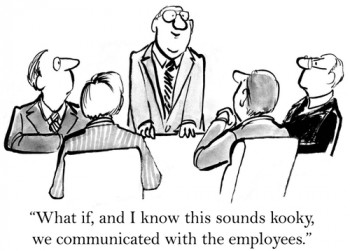Have you ever asked yourself that question? The pace and complexity of change in the workplace has increased dramatically. Benjamin Franklin once wrote, “In this world nothing can be said to be certain, except death and taxes”. In the modern world (aside from death and taxes), the only certainty is constant change.
Consider another question… If you are a leader who has ever implemented some sort of major change without taking into consideration the people who would be impacted by that change, what was the outcome?
Change Scenarios
For a moment, let us ponder the impact of change without having buy-in from the stakeholders involved. Imagine the following scenario:
Joe and Mary Blitzfitz have been married for 15 years. They have two children (Sally and Jack), along with a dog named Harry. The couple has been living in the same home for 8 years, in which Mary has taken great pains to decorate the house just the way she likes it. Recently, they have started to diligently save for both retirement and put money aside for the kids’ college funds.
One day, Joe learns that he is getting a promotion at work along with a large bonus. He decides that the family room in their home is long overdue for a makeover. He takes off work one day, and uses all of his bonus money to renovate the family room. He buys all new furniture and paints the walls. During all of this, he never once consults with his wife or children. How do you think his family will react when they arrive home to find the new living room?
How many times do situations like this occur in the professional world? Oftentimes, leadership will decide to implement some change without either considering how it will effect or engaging the rank and file for their input.
Just Get Over It
I once worked for a company that went through an ownership change. That alone brought about a multitude of changes, which were to be expected. After a while, I realized that the changes weren’t stopping and that the leadership of the new company had a culture of implementing change constantly: changes in technology platforms, changes in market and product focus, changes in organizational structure, changes in daily tools, and near weekly policy changes. All those changes took place without any form of change management.
Whenever questioned about the reasons for certain changes, one senior manager would often reference the book, Who Moved My Cheese by Dr. Spencer Johnson. I read the book, which is a good lesson in personal responsibility. However, in the context that this manager was using it, the message was, “change happens…get over it.”
Needless to say, this lack of change management had serious impacts to the culture within the company. Morale was very low and continued to drop. Revenue followed the same downward spiral, creating a cycle of even more change with even less communication. Employees, who once cared for the company, “got over it.” So did their customers.
Threats When Change is Not Managed Effectively
According to research conducted by Prosci, when the people who are affected by the change aren’t consulted or considered in the change, these threats take place:
- Productivity declines;
- Passive resistance escalates;
- Active resistance emerges and sabotages the change;
- Valued employees leave the organization;
- Morale deteriorates;
- Projects go over budget and past their deadline;
- Employees find workarounds to avoid the new way of doing things or revert to the old way;
- Divides are created in the organization between ‘us’ and ‘them’;
- The organization builds a history of failed and painful changes.
Success can still be a Failure?
Bringing projects in on time, on budget, and delivering requirements contributes to successful organizational change, but if the people involved in the change don’t embrace and adopt the new product, service, or result, the whole effort can be for naught. To achieve the most benefit, the people who use the solution need to want it and receive the necessary knowledge, ability, and support to use it.
Change management helps the people involved in the change participate and embrace the solution
Solarity’s Approach to Change Management
At Solarity, we work to consider the people involved in the change, and practice active organizational change management, a structured approach that ensures that changes are smoothly and successfully implemented to achieve lasting benefits.
Solarity’s approach can help you navigate the organizational changes you are facing more smoothly and achieve the benefits of the change more quickly.
Change Management Training
It helps to understand the change process, and utilize tools and techniques to prepare for, manage, and sustain change. Our courses help develop knowledge and skills related to change management awareness and build capacity.
Contact Cory Camic for more information about how we can help!
References:
- Best Practices in Change Management, Prosci Inc (2014)
